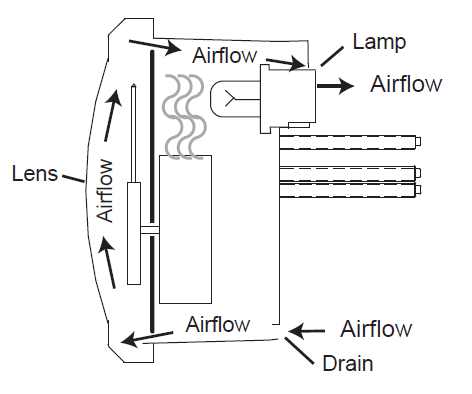Solution
 Instrument Fogging with Standard Glass Lens
Instrument Fogging with Standard Glass Lens
Most marine instruments have small vents in their cases to allow a way out for moisture that finds its way in. It is possible for moist air to be drawn into the vents when the air inside the gauge cools down after the instrument is turned off. The morning sun can draw this moisture up against the lens, causing fogging – a fine grey colored mist on the inside of the lens. Fogging is not abnormal, nor will it harm your instrument, which is built to withstand the harsh marine environment.
Conditions Which Can Lead to Fogging
Several environmental conditions can contribute to fogging; humidity, temperature changes, air flow and installation. Just like the mirror in the bathroom, when the temperature and the humidity from the shower or bath increases the mirror begins to fog. Like the mirror, the instrument will also start to fog as these conditions change. Although you cannot change the environment there is something that can be done to reduce fogging.
What You Can Do to Help Stop Fogging?
Turning on the instrument with the instrument light “on” will speed up moisture removal. The heat from the light and the electronics increases the temperature inside of the instrument. As the temperature increases the air is circulated around. The increased airflow should clear the lens of any fogging. This process is similar to what happens when you turn on the defroster in your car. The warm air blows across the glass reducing the fogging on your windshield.
 Change the Environment
Change the Environment
Increasing the flow of air to the rear of the instrument can help reduce fogging. If the instrument is mounted in the helm where air cannot flow freely the chance of the moisture being trapped and being drawn up into the instrument when cooled off is greatly increased.
The best way to prevent moisture build up is to create ventilation in the dash so that air can flow freely throughout. Installing a ventilation system with Louvers or vents increases the airflow and will help prevent fogging in the instruments by reducing the moisture in the environment.
If possible choose a location to mount the instrument where the instrument is facing out at close to a 90˚ axis from the deck. With the instrument in the straight up position the moisture is gathered at the top of the instrument and will help to reduce the fogging on the lens.
 Instruments with Fog Resistant Lenses
Instruments with Fog Resistant Lenses
These instruments are manufactured with a poly carbonate or glass lens which utilize an anti-fog coating. This coating helps reduce fogging by adding a water repelling film on the inside of the lens.
Even with the fog resistant coating, exposing the instrument to excessive humidity can cause moisture to condense on the lens (condensation). When washing your boat or storing your boat for long terms, consider venting the helm by opening access ways to allow air to flow more freely.
